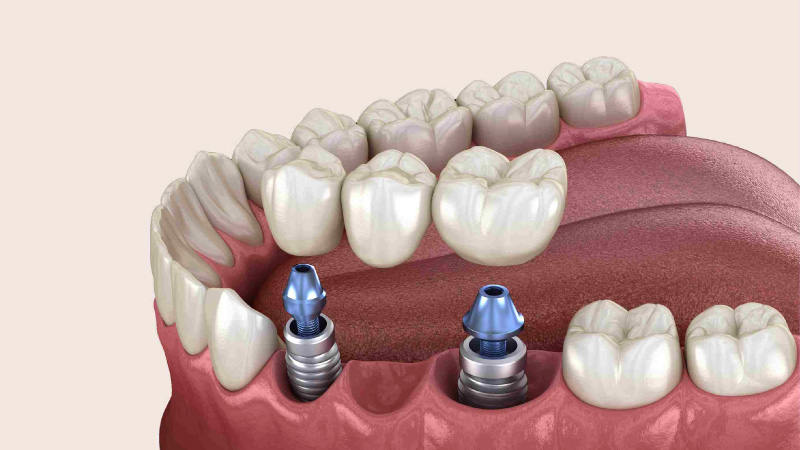Contents

Missing teeth occur due to any accident, teeth getting cracked beyond repair or suffering a blunt force trauma; these are no longer a matter of concern.
Replace the missing teeth that are preventing you from achieving your smiling benefits, which can be done with Dezy dental implant treatments.
A dental implant involves the replacement of an extracted tooth with a metal post screwed right into the bone that acts as an anchor to keep the crown or the permanent dentures in place.
Without the availability of dental implants, it would have been difficult to ensure effective treatment of total mouth cases or even provide a single crown restoration. The most appealing fact about dental implants is that they simulate natural teeth.
Dental Implants treatment is for those who are missing teeth and require replacement - it can be one or more teeth. Dental implants are a more permanent teeth restoration solution that is more dependable than dentures or dental bridges.
Dental implants also replace missing teeth with bone supports that may have withered away as a result of periodontal disease and if the dead tooth has not fallen off, it will require tooth extraction before the start of the dental implant process.
Before the Surgical Placement of the Dental Implants
- Before the placement of a dental implant, the consultation appointment with the dentist gives a brief idea to the patient about the procedure.
- X-rays and CBCT scans are done to provide an idea about the bone quality, height and width.
- The dentist may also explain the process of bone grafting and sinus lift if the patient does not have sufficient bone in the area.
- The material and the colour for the restoration (crown, bridge and denture) will be selected in this appointment.
Dental Implant Procedures: Step by Step
1. Surgical Placement of Implant:
With the ever-increasing innovations in the field of dentistry, dental implant placement has become a relatively anxiety-free and pain-free procedure. The first surgical procedure can be done under local anaesthesia or even under sedation.
The procedure starts with the preparation and drilling of the jawbone to receive the implant. In certain cases, a bone graft may be needed when the bone does not have enough height or is lacking strength.
2. Healing:
Following the insertion of the implant, a healing period of 3-6 months is observed to allow a proper union between the jawbone and the implant.
3. Abutments:
This is the second surgical procedure which is done to expose the implant head and provide an attachment for the final prosthesis which may be a crown, bridge, or denture.
4. Placement of a permanent prosthesis:
The last stage involves the placement of the final prosthesis which may be either a crown, bridge or denture to the implant. The prosthesis may either be cemented or screwed, once the surrounding tissue has healed, following the second surgery.
The surrounding supporting tissues, where the implant is meant to be inserted must be in excellent condition without symptoms of gingivitis or periodontitis as that may render the dental implant procedure unsuccessful.
Post-surgical dental implant placement care
- The patient is given post-operative instructions to maintain optimum oral hygiene to prevent any infection in the implant area.
- Brushing twice a day, mouth rinsing and flossing help to prevent the build-up of bacteria and add to the longevity of the implant life.
- The dentist will schedule regular follow-up appointments to ensure the maximum success of the implant.
- Follow-up X-rays will be taken for patient education and to assess the status of the dental implant.
- Regular professional cleaning is necessary to remove plaque or calculus (hardened plaque) to prevent inflammation of the surrounding soft tissues.
- The teeth bite may be adjusted to ensure no heavy load on the implant.
If you do not have enough bone in your jaw required to hold an implant as shown in the consultation x-rays & CT scans, the dentist will discuss your options for bone augmentation.
Types of Augmentation Procedures for Dental Implants
Sinus augmentation:
This is a procedure which helps raise the sinus floor to increase the quantity of bone available to insert dental implants in the posterior part of the upper jaw.
This procedure is usually done if there is a possibility of damage to the floor of the sinus during the surgical placement of the implant.
Ridge modification:
This procedure is done to modify any defects in the ridge of the jawbone and is corrected by the procedure of bone grafting. Bone grafting can be done with the help of various autogenous, allogenous or alloplastic bone graft materials.
The correction of ridge defects helps in improving the quality and the quantity of bone available for surgical insertion of dental implants.
Types of Bone Grafts Used for Augmentation
Autogenous Grafts:
In this type of graft, the bone from another part of the body is used as a graft material.
Allografts
In this case, the graft material is from another human donor.
Xenografts:
These bone grafts are from another species most likely cow (bovine bone).
Alloplastic:
These are synthetic bone substitutes, similar to human bone that provide a framework for natural bone formation.
Missing teeth should no longer be a concern for anyone, search for ‘Dental Implants Near Me’ and get that procedure kick-started.



